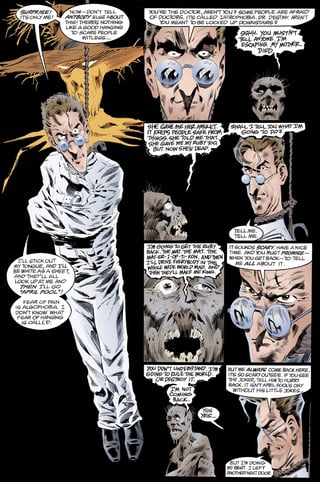Early in The Sandman comics, we see appearances from the Justice League, Gotham, Arkham Asylum, John Constantine and others. As the series progresses we see fewer and fewer cameos. Did Gaiman ever address why this was? Was it a directive from DC, a story-based decision, or something else?
2 Answers
Originally, Sandman was conceived very much as part of that world. (Gaiman had originally intended to revive the 30s pulp character with the gas mask - who of course makes a brief cameo in book one of Sandman, and whose revival later happened as Sandman Mystery Theatre.) It was Karen Berger's suggestion that he create a completely new character.
So as designed, the Sandman was not a superhero story, it was a horror story set entirely in dreams - a genre in which superheroes don't really fit well. In the early issues he was still experimenting with genres, and each issue is a slightly different kind of horror or dark fantasy - but they're all essentially horror/fantasy stories.
In the afterword to the first book, Gaiman describes the issue in which the JLA appear, "Passengers", as "my (perhaps misguided) attempt to try to mix super-heroes into the Sandman world."
So it seems pretty clear that Gaiman made an early attempt to mix them in, decided it didn't work well, and left it at that. (He throws in the occasional cameo when they're actually a useful fit for the tone of the story; most notably in "Facade". But that story is itself about the contrast between a realistic world and the simpler tone and assumptions of an archetypal superhero story.)
-
I always assumed it had to do with Karen Berger wanting to "Test the waters" of how Vertigo would be accepted as an outside DC Universe line.– Monty129Commented Jan 25, 2013 at 12:55
-
4@Monty129 - A good assumption, except that Vertigo as an imprint didn't exist until 1993, four years after the series started. Commented Jan 26, 2013 at 7:05
-
2I personally thought The Martian Manhunter appearance was pretty great. Commented Sep 18, 2016 at 1:00
-
1I'd take issue with Sandman being "horror". To my mind it's straight fantasy, which can be hoffic, but is never a horror. Commented Mar 31, 2017 at 11:04
-
1@AndrewTice In general across the plot of Sandman, it's a fantasy. In book 1, where the author was still searching for the right tone and experimenting with superheroes - it's largely horror. (I certainly can't think of any other way to describe "...Dream a Little Dream of Me" or "24 Hours".)– TynamCommented Apr 1, 2017 at 12:07
To offer another look on the issue - Neil Gaiman explained in an interview with Chip Kidd that there was also the concern for continuity with other DC comics. It turns out that in the issue where Dr. Dee escapes from Arkham Asylim (in #5, "Passengers"), it was supposed to be the Joker, and his April Fool's joke (hanging himself), rather than Scarecrow.
However, Gaiman was told that Joker had just died in another comic, so he couldn't appear in The Sandman. In this light, Scarecrow saying
If you see the Joker, tell him to hurry back. It isn't April Fool's Day without his little jokes...
gains another meaning (we that @Shokhet for spotting that interpretation).
Gaiman explains that he ran into similar problems multiple times (in The Wake, Superman was originally to have his cape stick out of his cloak, and constantly look back at it afraid, it would expose him), and the issues - having to synchronise the continuity of The Sandman with another comic, and having to approve it - was too much hassle.
This is the interview (the relevant portion starts at 57:32):
-
2Nice answer. After listening to the first few minutes of the interview, the Scarecrow's statement "If you see the Joker, tell him to hurry back" takes on somewhat of a different (and more meta) meaning.– ShokhetCommented Jun 8, 2017 at 17:39
-
@Shokhet I had not actually noticed that before! Thanks, I'll add that! Commented Jun 8, 2017 at 17:40

